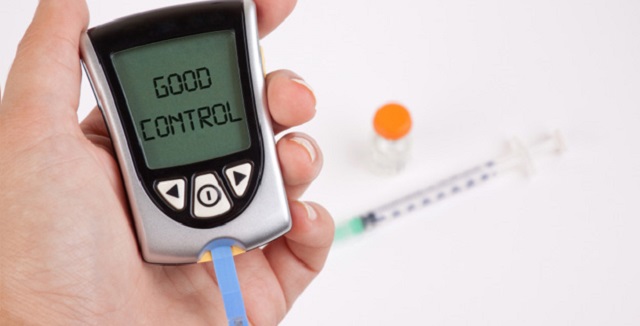How to Control Blood Sugar

Understanding how to control blood sugar is critical for the successful management of Type 2 diabetes. This article is about navigating the often complex course of managing diabetes.
Blood sugar test tools are helpful in tracking how well your diet, physical activity, and other lifestyle changes are controlling your blood sugar levels.
Life with Diabetes
The Type 2 diabetic’s life is often complex. It’s a constant effort to stabilize blood sugar levels. After the doctor’s consultation, it’s up to you to implement the recommendations and take the medications prescribed as part of the Type 2 diabetes management plan.
Diabetes and Blood Sugar
The American Diabetes Association (ADA) says that the body uses sugar for fuel. Insulin, produced by the pancreas, helps the body’s cells to properly use the glucose sugar.
Type 2 diabetes happens if the body can’t remove sugar from the bloodstream. This may result if the diabetic is dealing with insulin sensitivity or if it responds inappropriately to the changes in blood sugar levels:
- An individual is considered diabetic if his or her blood sugar levels are elevated (typically greater than 126 mg/dL in a fasting blood sugar test, or higher than 200 mg/dL at other times of the day.
- Diabetes may be present if the individual’s A1C level is higher than 6.5 percent or more. The A1C test measures the individual’s percent of blood sugar bound to blood hemoglobin over the previous two – three month period. Hemoglobin is a red blood cell protein used to transport oxygen in the body. A 6.5 percent A1C result means that about 6.5 percent of the individual’s red blood cells are bound to sugar molecules.
When high blood sugar is uncontrolled, it causes damage to the body’s blood vessels. In the long term, the progressive harm of high blood sugar can result in loss of nerve sensations in the extremities, diminished eyesight or blindness, and higher risks for stroke, heart, and brain disease.
High and low blood sugar levels threaten health.
Low blood sugar may result in hypoglycemia. This condition places the hypoglycemic at risk for loss of consciousness and mental confusion. It may be life-threatening.
High blood sugar, in comparison, may cause dehydration or fatigue in the early stages. Knowing how to control blood sugar can help the diabetic to reduce his or her risk of heart attack, peripheral artery disease, stroke, kidney disease, or vision loss.
Strategies to Control Blood Sugar
Achieving blood sugar control may require trial and error. It’s important to take a systematic approach to controlling blood sugar, including:
- Establish a daily routine. Automaticity can make it easier to control blood sugar.
- Loss weight if overweight. This will help to control blood sugars.
- Test blood sugar consistently. Check your blood sugars throughout the day to achieve better control.
- Follow a nutritional meal plan. The ADA reports that diabetics achieve greater blood sugar control by limiting foods that cause their blood sugar levels to spike. It may be beneficial to consume more vegetables, fruits, and lean protein and limit simple carbohydrates like white flour and sugar. Adding more plant-based fibrous foods to the diet can help diabetics to lose weight.
- Drink in moderation. If you consume alcoholic beverages, do so in moderation. Eat food when you drink alcohol to slow the body’s absorption.
- Exercise regularly. Researchers report that exercise is one of the best ways to control blood sugar over the long-term. (“Journal of Sports Medicine & Physical Fitness,” 2015). Include aerobic exercise and strength training or any enjoyable physical exercise.
- Track carbohydrates consumed each day: Daily variations in carbohydrates from day to day can cause blood sugar fluctuations.
- Follow-up with the internist or endocrinologist. Your doctor may prescribe medicines, including:
- Biguanides, such as metformin, to help the body better use insulin and reduce the amounts of blood sugar produced by the liver.
- Sulfonylureas support the pancreas’ ability to produce more insulin. Note that low blood sugar may be a possible side effect of using this medication.
- Meglitinides, such as repaglinide, also help the pancreas to produce more insulin. Low blood sugar may result.
- Alpha-glucosidase inhibitors, such as acarbose, inhibit the body’s ability to process starchy foods. This can help to control an after-meal blood sugar spike.
- DPP-4 inhibitors are used to extend the life GLP1 (a natural gut hormone). This can help the user to control blood sugar levels.
- Thiazolidinediones, such as pioglitazone, work to reduce the diabetic’s insulin resistance.
- SGLT2 Inhibitors push excessive glucose into the urinary tract.
- Insulin is needed by Type 1 diabetics (and some Type 2 diabetics) to help control blood sugar.
Ask Your Doctor Questions about Diabetes Blood Sugar Control
Ask the diabetes educator or physician about how to understand your blood sugar numbers. He or she can provide clear instructions to assist your efforts to control blood sugar:
- Understand why the doctor prescribed a medication.
- Know what your goals are for using any treatment.
The more you know about diabetes, the better you can achieve blood sugar control.